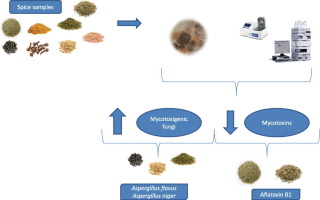Food Research International ( IF 7.0 ) Pub Date : 2017-12-26 , DOI: 10.1016/j.foodres.2017.12.061 Marcelo Valle Garcia , Carlos Augusto Mallmann , Marina Venturini Copetti

|
During their processing, spices usually remain close to the ground for drying, a fact that disposes to fungal contamination, as well as moisture transferred from the tropical environment can allow their multiplication and synthesis of mycotoxins. The objective of this study was to evaluate the presence of potentially toxigenic fungi and mycotoxins in spices marketed in Brazil. The fungal contamination was evaluated by direct plating for samples of clove, black and white peppers. Spread plate was used for the samples of rosemary, cinnamon, fennel, pepperoni pepper and oregano. Analyses were performed in triplicate in DG18 media with incubation at 25 °C for 7 days. The isolation and identification of fungi followed specific recommendations of culture media and incubation period for each genus. The presence of mycotoxins in spices was verified by high-performance liquid chromatography (HPLC) coupled to fluorescence. The frequency of species potentially toxigenic was high in white and black peppers with presence of both aflatoxigenic and ochratoxigenic fungi. Only rosemary and fennel showed contamination with aflatoxin B1 and there was a positive correlation (ρ < 0.01) between the rosemary contamination with the presence of AFB1 and A. flavus. Even in the presence of ochratoxigenic fungi, ochratoxin A was not detected in the samples. The presence of natural components with antimicrobial activity could justify the low presence of mycotoxins, even in the presence of known toxigenic fungi in the samples. Mycotoxins were not detected in spices covered by Brazilian regulation of mycotoxins. On the other hand, these contaminants were present in other spices consumed by population and not mentioned in the regulation, which could be considered a cause to concern.
中文翻译:

巴西销售的香料中的黄曲霉毒素和产毒毒素真菌及其霉菌毒素
在加工过程中,香料通常保持靠近地面干燥,这会造成真菌污染,以及热带环境中转移的水分会导致其繁殖和合成霉菌毒素。这项研究的目的是评估在巴西销售的香料中潜在的产毒真菌和霉菌毒素的存在。通过直接电镀丁香,黑胡椒和白胡椒样品来评估真菌污染。涂板用于迷迭香,肉桂,茴香,意大利辣香肠胡椒和牛至的样品。在DG18培养基中一式三份进行分析,并在25°C下孵育7天。真菌的分离和鉴定遵循培养基的具体建议和每个属的潜伏期。香料中霉菌毒素的存在通过与荧光偶联的高效液相色谱(HPLC)进行了验证。在具有黄曲霉毒素和ra曲霉毒素真菌的白胡椒和黑胡椒中,具有潜在毒性的物种的频率很高。只有迷迭香和茴香显示出了黄曲霉毒素B1的污染,并且存在AFB1的迷迭香污染与AFB1的存在呈正相关(ρ<0.01)。黄曲霉。即使存在产ra曲毒素的真菌,样品中也未检测到曲霉毒素A。即使样品中存在已知的产毒真菌,具有抗微生物活性的天然成分的存在也可以证明霉菌毒素的低存在是有道理的。巴西霉菌毒素法规涵盖的香料中未检测到霉菌毒素。另一方面,这些污染物存在于人口消费的其他香料中,法规中未提及,可能被认为是引起关注的原因。











































 京公网安备 11010802027423号
京公网安备 11010802027423号